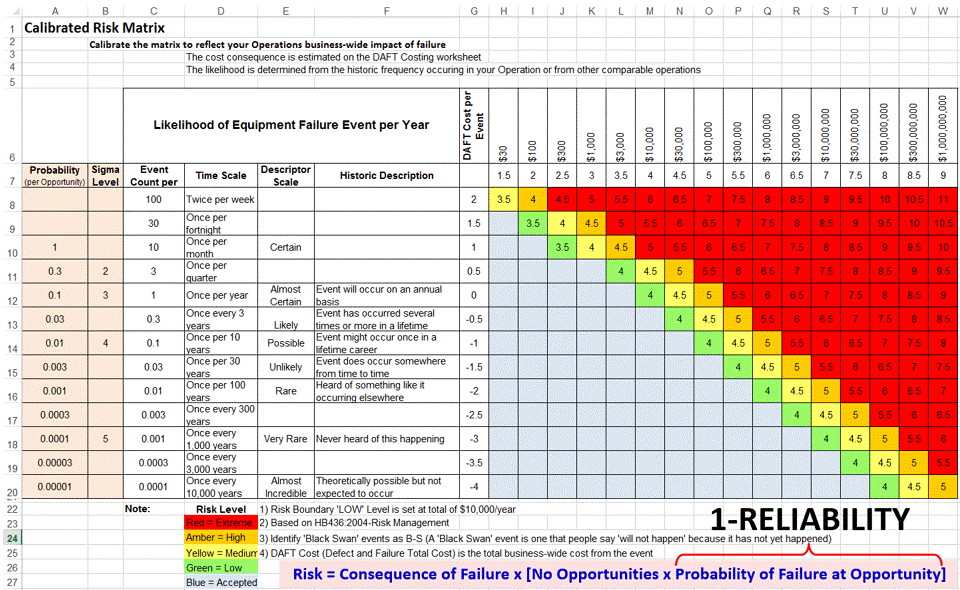Stop risk blindness: Use a risk cost calculator and plot movements in your business risk on a 16×13 risk matrix
Here is a simple visual management tool to let you see the impact of changing risk. Combine it with a risk cost calculator and you have an effective way to see how your risk changes with risk management plans and risk abatements
We are blind to risk. Most of us have to suffer a risk event before we know we are in one. We first experience pain and then we realise that we need to stop doing what is causing the pain.
This is feedback control in action. Humans learn by using feedback—we make the choice first and if it’s a mistake we then learn from it. That is ‘fire-ready-aim’ thinking. It may be an acceptable approach when the consequences are low, but it is a disastrous practice when consequences are high. In high risk situations you need feed-forward control—make the best choice first, then action it: a ‘ready-aim-fire’ approach.
The risk matrix was invented to show us the levels of risk associated with our actions. In Safety Management a 5 x 5 risk matrix is often used for assessing and showing workplace safety risk. The levels of risk are colour coded and the cells can be individually numbered to signify a risk value. International Standard ISO 31000 Risk Management Guidelines is a commonly used method to develop a risk matrix calibrated to your organisation’s circumstances. There are many other acceptable risk assessment and risk management methods in use.
The consequence and likelihood values on a risk matrix are usually expressed in log to the base ten units (log-10). 1,000 is mathematically 3 in log-10 notation. Odds of 1 in 1000 is mathematically -3 (i.e. negative 3) in log-10, but usually shown as 0.001 on the matrix. Each cell represent 90% of the linear distance between values, e.g. one cell covers 1 to 10, another cell covers 10 to 100, one more for 100 to 1,000, another for 1,000, to 10,000, and so on.
In order to show risk moving you need a risk matrix where you can clearly see the risk shift from one cell to another. A 5 x 5 risk matrix is too cramped to easily observe risk movements. In a cell that represents risks ranging from $100,000 to $1,000,000 you will not see a $500,000 shift in risk from $200,000 to $700,000. The $500,000 difference is buried within the one cell. To view risk moving a risk matrix needs to have more cells representing smaller ranges of risk.
With a simple enhancement to a standard log-10 risk matrix you can rescale the units and use it to clearly see the changes in your business and operating risk. In the first image below we turned a 5 x 5 risk matrix into a 16 across x 13 down risk matrix. We divided the log-10 cells in half at the midpoint between the log-10 major units and extended it to cover from $30 to a billion dollars. This 16 x 13 risk matrix is calibrated at $10,000/year as the upper limit of ‘low’ risk. There are five risk levels starting from acceptable risk (blue) to low (green), medium (yellow), high (orange) and extreme (red). If it is necessary to show fine movements of risk you could adopt a real log-10 scale and show risk movements as small as a tenth of the value between the major units.

In the second image we used the 16 x 13 risk matrix to show the movement in operating risk as a conveyor roller degrades from correct operation ($1,000/yr to maintain) to a roller with a siezed bearing ($37,000 to replace), then to a knife-edge worn into the roller by the rubbing conveyor belt that rips a conveyor full length ($200,000 to replace the belt), and finally a totally burnt-out conveyor system if shaved rubber accumulates around the drive motor and catches fire ($2,000,000 to rebuild the conveyor system).

How to Use a Risk Cost Calculator to Model Changing Risk
The image below shows a risk cost calculator in use. In each column you see various risk scenarios being modelled. Each scenario arrives at a value of business risk, and its associated consequent cost, caused by the strategy selected.
This risk cost calculator was developed for the siezed conveyer roller. It represents the business and operational risk scenarios for each progressive stage as the conveyor roller degrades.
The risk for each scenario in the risk cost calculator was then plotted on the 16 x 13 risk matrix above to make each risk ‘visible’ to us. With the risk cost calculator values shown in the risk matrix you can easily understand how the business risk moves out of the acceptable zone and into higher risk zones.

With a risk cost calculator to estimate costs and a risk matrix to show the changes in your business and operational risk you are no longer ‘blind to risk’. You more fully appreciate the real risk situations you face and can make better, sounder decisions.
All the best to you,
Mike Sondalini
Managing Director
Lifetime Reliability Solutions HQ